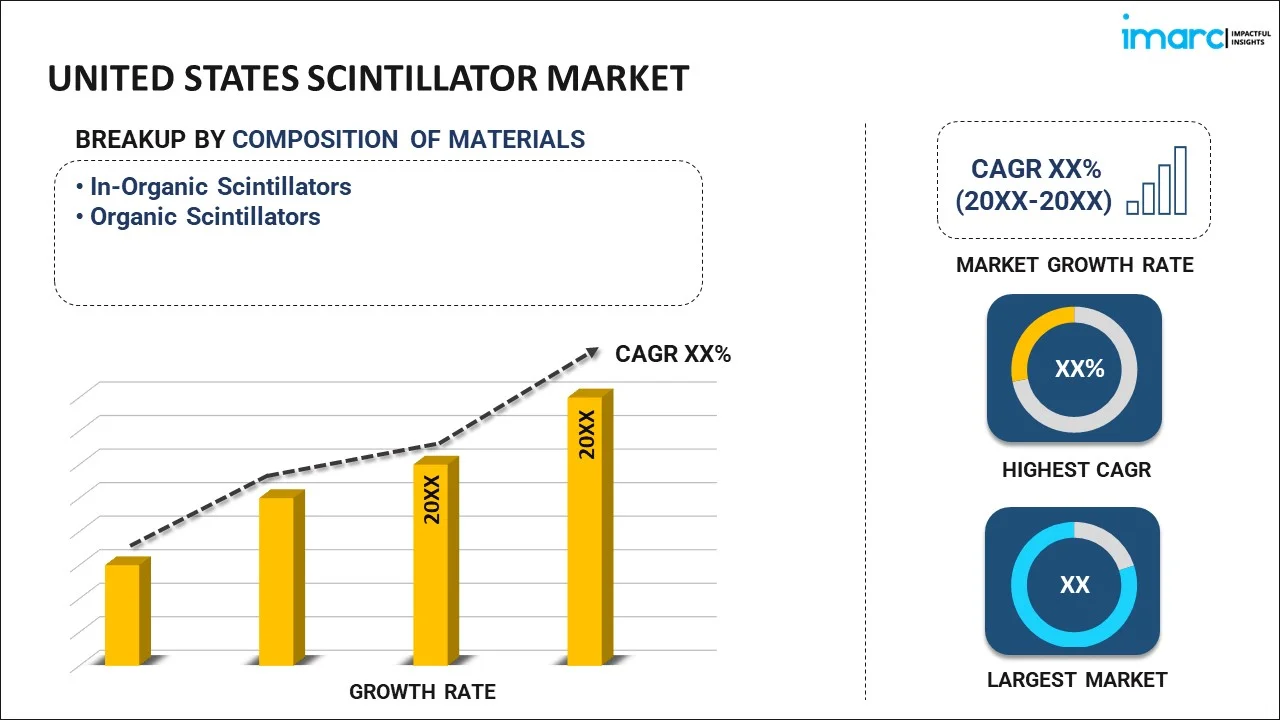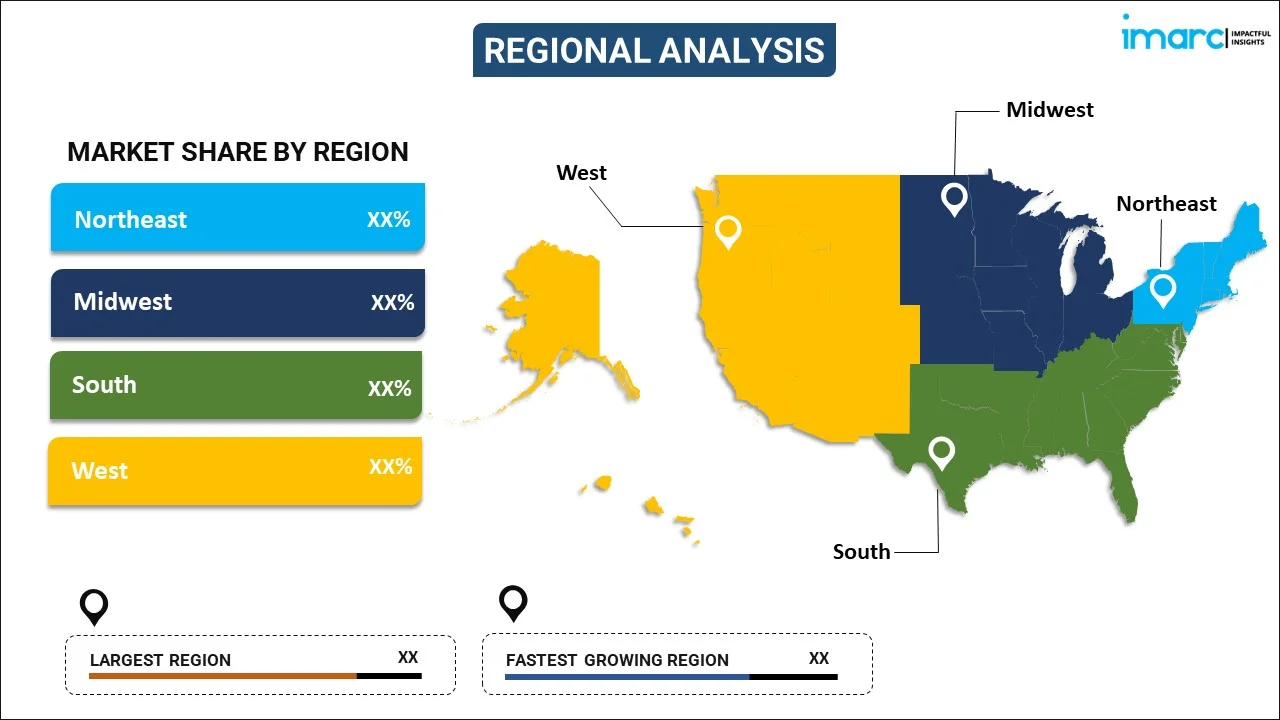
United States Scintillator Market Report by Composition of Material (In-Organic Scintillators, Organic Scintillators), End Product (Personal or Pocket Size Instruments, Hand-Held Instruments, Fixed, Installed, and Automatic Instruments), Application (Healthcare, Nuclear Power Plants, Manufacturing Industries, Homeland Security and Defense, and Others), and Region 2024-2032
Market Overview:
The United States scintillator market size reached US$ 184.0 Million in 2023. Looking forward, IMARC Group expects the market to reach US$ 272.5 Million by 2032, exhibiting a growth rate (CAGR) of 4.3% during 2024-2032.
|
Report Attribute
|
Key Statistics
|
|---|---|
|
Base Year
|
2023
|
|
Forecast Years
|
2024-2032
|
|
Historical Years
|
2018-2023
|
|
Market Size in 2023
|
US$ 184.0 Million |
|
Market Forecast in 2032
|
US$ 272.5 Million |
| Market Growth Rate 2024-2032 | 4.3% |
Scintillators are materials that absorb high-energy photons and incident particles to emit pulses of light. These materials convert gathered energy into the ultraviolet (UV) range of photons, which ensure detection by photomultipliers and photodiodes. They also help in determining the energy and time of incident radiation efficiently. Moreover, they are more sensitive to deposited energy as compared to other types of radiation detectors. Consequently, they are used in nuclear plants, medical imaging, high-energy particle experiments and national security in the United States.
Scintillators are integrated into medical devices, such as X-ray machines, computerized tomography (CT), positron emission tomography (PET) and single-photon emission computerized tomography (SPECT) scanners. The rising prevalence of cancer, along with the increasing utilization of radiation therapy, represents one of the significant factors bolstering the growth of the market in the United States. Additionally, stringent homeland security measures in the country are further impelling the market growth. For example, the United States Department of Homeland Security (DHS) is supporting the development of solid organic scintillators for detecting radioactive substances and preventing radiological threats under the Exploratory Research and Small Business Innovative Research programs. Apart from this, scintillators are used in several industries for monitoring contamination and analyzing thermal neutron activation during the manufacturing processes.
Key Market Segmentation:
IMARC Group provides an analysis of the key trends in each sub-segment of the United States scintillator market report, along with forecasts at the country and regional level from 2024-2032. Our report has categorized the market based on composition of material, end product and application.
Breakup by Composition of Material:

- In-Organic Scintillators
- Alkali Halides
- Oxide Based Scintillators
- Others
- Organic Scintillators
- Single Crystal
- Liquid Scintillators
- Plastic Scintillators
Breakup by End Product:
- Personal or Pocket Size Instruments
- Hand-Held Instruments
- Fixed, Installed, and Automatic Instruments
Breakup by Application:
- Healthcare
- Nuclear Power Plants
- Manufacturing Industries
- Homeland Security and Defense
- Others
Breakup by Region:

- Northeast
- Midwest
- South
- West
Competitive Landscape:
The competitive landscape of the industry has also been examined along with the profiles of the key players.
Report Coverage:
| Report Features | Details |
|---|---|
| Base Year of the Analysis | 2023 |
| Historical Period | 2018-2023 |
| Forecast Period | 2024-2032 |
| Units | US$ Million |
| Segment Coverage | Composition of Material, End Product, Application, Region |
| Region Covered | Northeast, Midwest, South, West |
| Customization Scope | 10% Free Customization |
| Report Price and Purchase Option | Single User License: US$ 3699 Five User License: US$ 4699 Corporate License: US$ 5699 |
| Post-Sale Analyst Support | 10-12 Weeks |
| Delivery Format | PDF and Excel through Email (We can also provide the editable version of the report in PPT/Word format on special request) |
Key Questions Answered in This Report:
- How has the United States scintillator market performed so far and how will it perform in the coming years?
- What has been the impact of COVID-19 on the United States scintillator market?
- What are the key regional markets?
- What is the breakup of the market based on the composition of material?
- What is the breakup of the market based on the end product?
- What is the breakup of the market based on the application?
- What are the various stages in the value chain of the industry?
- What are the key driving factors and challenges in the industry?
- What is the structure of the United States scintillator market and who are the key players?
- What is the degree of competition in the industry?
Need more help?
- Speak to our experienced analysts for insights on the current market scenarios.
- Include additional segments and countries to customize the report as per your requirement.
- Gain an unparalleled competitive advantage in your domain by understanding how to utilize the report and positively impacting your operations and revenue.
- For further assistance, please connect with our analysts.
 Inquire Before Buying
Inquire Before Buying
 Speak to an Analyst
Speak to an Analyst
 Request Brochure
Request Brochure
 Request Customization
Request Customization




.webp)




.webp)












